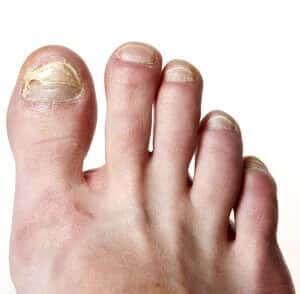
Toenail fungus is ugly. It turns toenails yellow and crumbly and makes them thick. They become difficult to cut. But drugs for nail fungus have drawbacks. Oral medications such as itraconazole (Sporanox) or terbinafine (Lamisil) may occasionally produce side effects such as nausea, rash or, in the case of itraconzole, congestive heart failure. Terbinafine has been linked to immune system disorders and liver damage. Even though such reactions are far from common, people who learn about them are understandably reluctant to risk them for the sake of prettier toenails. So is there a more natural way to help toenail fungus clear up?
Are There Natural Approaches That Help Toenail Fungus?
Q. I just saw an ad on the Internet about a toenail fungus product containing baking soda, animal fat and coconut oil. The visual was of someone’s feet soaking in a solution.
Will a natural treatment like this solve this problem? Does any natural treatment solve toenail fungus?
A. We are not familiar with this greasy-sounding approach to nail fungus. There are, however, many natural approaches that can be helpful against this problem.
Remedies That May Help Toenail Fungus Disappear:
Oily remedies to help toenail fungus include applying tea tree oil or Vicks VapoRub directly to the nails. There are even a few studies of Vicks against toenail fungus (Snell et al, Journal of the Association of Nurses in AIDS Care, Jan-Feb. 2016; Derby et al, Journal of the American Board of Family Medicine, Jan-Feb. 2011). Vicks VapoRub contains camphor, eucalyptus oil and menthol as its active ingredients against cough. We suspect some of the inactive ingredients are also working against toenail fungus: cedarleaf oil, nutmeg oil, thymol and turpentine oil. Both the cedarleaf oil and the turpentine oil may have some components similar to those of Norway spruce resin. A Finnish test of the coniferous resin found it could help toenail fungus, at least modestly (Sipponen et al, Mycoses, May 2013).
Other Nail Fungus Remedies:
Some people report success from soaking their feet in a 50/50 solution of amber Listerine and white vinegar. Others have used even more unorthodox treatments, such as soaking the affected toenails in cornmeal mush.
Vitamin E Oil to Fight Fungus:
After we wrote about pricking a capsule of vitamin E to let the oil drip out, we heard from a reader about a simpler approach.
Q. You recently wrote about treating nail fungus with vitamin E. You’d have to break the capsules with a pin and squirt the liquid onto the toe. You cited a dermatologist who recommended 400 IU capsules.
It sounded good to me, so I went in search of those magic capsules. To my amazement, I found vitamin E oil: 13,000 mg (30,000 IU) per bottle. The directions said nothing about toenail fungus, but of course I took a bottle home and used it. It’s so much easier than poking a pill with a pin!
Urine Against Toenail Fungus:
One enterprising individual tested the “urine cure” by soaking one foot and not the other. After two months, this reader noted a visible difference.
Quite possibly the active agent in urine is urea. The Mayo Clinic website recommends treating fungus-infected toenails with urea-containing cream to soften them before trimming and filing.
You can learn more about a variety of remedies to help toenail fungus clear up in our book, The People’s Pharmacy Quick & Handy Home Remedies.

